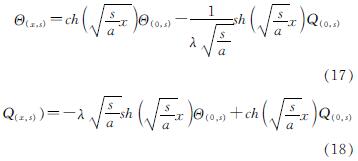基金项目:“十三五”国家重点研发计划课题项目(2017YFC0702400)
第一作者:赵 群(1975-),女,副教授,主要从事被动式建筑技术设计研究.E-mail: qunzhao@126.com 通信作者:谢一建(1993-),男,硕士生,主要从事围护结构热工性能研究.E-mail: xie_1jian@126.com
(1.同济大学 建筑与城市规划学院,上海 200092; 2.同济大学 机械与能源工程学院,上海 201804)
(1.College of Architecture and Urban Planning, Tongji University,Shanghai 200092, China; 2.School of Mechanical Engineering, Tongji University, Shanghai 201804, China)
Lhasa area; enclosure structure; solar thermal utilization; heat transfer and storage
DOI: 10.15986/j.1006-7930.2021.06.012
围护结构作为建筑室内外热环境交换的媒介,其保温性能通过控制室内热量的散失或流入、蓄热性能通过蓄存热量对室内热环境产生影响.研究表明围护结构的保温性能改造有助于长时间保持室内在冬季和夏季的舒适,降低建筑能耗最高达80%[1-8].蓄热性能通过“移峰填谷”作用能够有效抵御室外温度的剧烈变化,调节室内热环境,夏季能够节约空调用电量8%左右,冬季可以减少供热量达43%[9-15].
对于属于寒冷地区的拉萨,昼夜温差大,其传统民居围护结构呈现出与内地建筑围护结构不同的特点:厚度大,约500~800 mm; 采用重质材料如黏土、石块等.这种特点使得其具有良好的保温性能,另一方面,在藏区太阳能资源丰富、昼夜温差大的气候条件下,这种构造特点也使得围护结构具有良好的蓄热性能,从而维持稳定的室内热环境.但传统民居围护结构的做法仍然有局限性,为了进一步提高室内温度及维持室内温度的稳定,有必要加强围护结构的保温和蓄热性能设计.目前的设计思路是以提升保温性能为主,通过构造保温复合墙体来提高围护结构热阻,实现保温改造[16-18]; 蓄热性能的优化是作为辅助手段,以维持室内温度的稳定为目标,给出热惰性指标推荐值或是提出具体墙体构造建议[16,18-20].另一方面,当地强太阳辐射的气候条件也成为围护结构热工设计时考虑的因素之一,桑国臣等考虑到建筑不同朝向受太阳辐射影响的不同,提出了非平衡保温的概念,在保温成本一定的条件下,理论上非平衡保温能够达到对室内热环境的最佳改善效果[21-23].可以看出,即使在考虑了太阳辐射的条件下,当地围护结构的热工设计的仍侧重于保温性能,蓄热性能则以维持室内温度的稳定为目的.但围护结构特别是墙体作为建筑的主体,具有较大的蓄热容量,从蓄热载体的角度探讨其对室内热环境的影响也具有一定的意义.
在现有的围护结构热工性能研究中,墙体材料基本热工性能参数:导热系数λ、密度ρ、比热容c和墙体的厚度构成了评价墙体热工性能的两类参数:R=d/λ热阻,用于评价墙体的保温性能;  墙体蓄热系数或
墙体蓄热系数或 墙体热惰性指标,用于评价墙体的蓄热性能.对于热阻,它可以反映墙体阻止室内热量流失或流入的能力,在关注墙体的蓄热载体作用时,仍然可以作为评价参数.对于蓄热性能的两种参数,除了与墙体材料的热工性能参数有关,也与外扰变化的周期有关,体现了对外扰变化的响应能力.但从蓄热载体的角度,应着重考虑其蓄热容量的大小,另一方面,墙体能够发挥多少蓄热能力,也与能够进入墙体热量的多少有关,即受墙体传热性能的影响.相关研究表明,保温性能对蓄热性能的作用过程产生影响[24-26],并且二者之间存在一个最佳组合使得对室内热环境的改善效果达到最佳,建筑能耗也能达到最低[27-29].但这些研究多是从材料的基本热工性能参数的角度讨论各参数之间的影响,而没有涉及围护结构保温与蓄热性能之间的相互影响和权衡问题.
墙体热惰性指标,用于评价墙体的蓄热性能.对于热阻,它可以反映墙体阻止室内热量流失或流入的能力,在关注墙体的蓄热载体作用时,仍然可以作为评价参数.对于蓄热性能的两种参数,除了与墙体材料的热工性能参数有关,也与外扰变化的周期有关,体现了对外扰变化的响应能力.但从蓄热载体的角度,应着重考虑其蓄热容量的大小,另一方面,墙体能够发挥多少蓄热能力,也与能够进入墙体热量的多少有关,即受墙体传热性能的影响.相关研究表明,保温性能对蓄热性能的作用过程产生影响[24-26],并且二者之间存在一个最佳组合使得对室内热环境的改善效果达到最佳,建筑能耗也能达到最低[27-29].但这些研究多是从材料的基本热工性能参数的角度讨论各参数之间的影响,而没有涉及围护结构保温与蓄热性能之间的相互影响和权衡问题.
综上所述,在拉萨地区,只从室内“维稳”的角度研究围护结构的蓄热性能存在一定的局限性,也可以从蓄热载体的角度出发,在这种情形下,需要探讨保温性能对蓄热性能的影响.本文结合现有的研究基础与实际背景,提出一种表征单层墙体蓄热与传热性能相对强弱的参数RSHST,并通过模拟案例说明在拉萨地区的气候条件下,南向墙体RSHST数对室内热环境的影响.
由于围护结构高度h与厚度δ之比大于10,因此可将其壁体传热过程视为一维非稳态导热过程[30],假设围护结构为均质墙体,其传热与蓄热过程如图1所示.
壁体的导热微分方程[31]:

式中:λ为壁体材料导热系数,W/(m·k); ρ为壁体材料密度,kg/m3; c为壁体材料比热容,J/(kg·K).
边界条件与初始条件:
t(x,τ)|x=0=t(0,τ)℃(2)
t(x,τ)|x=δ=t(δ,τ)℃(3)
t(x,τ)|τ=0=t(x,0)℃(4)
式中,δ为壁体厚度,m.
壁面导热量及壁体蓄热量:
导热量计算式为

外壁面导热量为

内壁面导热量为

壁体蓄热量:根据能量守恒,有
q(b,τ)=|q(0,τ)-q(δ,τ)| W/m2(8)
现假设围护结构的热流传递过程为室外侧传向室内侧,由于围护结构非稳态传热特征,进入壁体的热量即外壁面导热量q(0,τ)沿途不断地被吸收而使壁体温度升高,壁体吸收的热量为q(b,τ),最终到达内壁面的热量即内壁面导热量为q(δ,τ),导致外壁面吸收的热量不能立即、完全地传入室内,而是部分蓄存在壁体内,逐渐地传向室内或室外.
三种热量q(0,τ)、q(b,τ)、q(δ,τ)的大小,主要受围护结构保温性能与蓄热性能的影响.壁体导热系数λ越大,在相同的温度梯度下可以传导更多的热量,q(0,τ)也越大; 而壁体的体积热容ρc越大,温度上升1 ℃所吸收的热量越大,即q(b,τ)越大,则到达内壁面的热量q(δ,τ)就越小[32].因此,当保温性能优异时,q(0,τ)数值较小,当蓄热性能优异时,壁体的蓄热量q(b,τ)较大,则q(δ,τ)较小.
如图2所示,为保温性能与蓄热性能对上述三种热量大小影响的定性表示.可以看出,低保温能使白天围护结构吸收更多的热量q(0,τ),而蓄热性能使得这些热量的一部分q(b,τ)蓄存在壁体内,一部分q(δ,τ)传向室内; 在夜间,蓄存在壁体内的热量,同时向室内侧和室外侧放热.图2中所示的q(δ,τ)为白天室内侧放热量,与q(0,τ)、q(b,τ)同时发生,而在以改善夜间室内热环境为目标的条件下,夜间放热量q(δ,τ)是需要关注的重点.此时的q(δ,τ)不仅与围护结构的保温性能有关,也与白天的q(b,τ)有关,而q(b,τ)又与白天的q(0,τ)有关.因此,q(δ,τ)主要受围护结构的保温与蓄热性能影响,而保温对蓄热性能也产生影响.
为解决围护结构太阳能热利用与室内热量损失对围护结构热工性能产生的不同需求的问题,寻求围护结构保温与蓄热性能之间的平衡,本文试图提出一种评价围护结构蓄热性能与传热性能相对强弱的参数,该参数是围护结构本身的属性,只与围护结构本身的热工性能参数及尺寸有关,而与外界条件无关.
基于此目标,可以从直观反映两者大小的三种热量出发,找到三种热量与围护结构参数之间的关系,而式(1)~(7)是围护结构传热过程的微分形式的表达,需要对其进行求解.本文运用拉普拉斯变化法进行求解,得到单层平壁结构非稳定传热的传递矩阵[31].
对边界条件及初始条件作如下假设:
(1)零时刻整个墙体的温度保持为k℃,即式(4)为t(x,0)=k ℃;
(2)外侧壁面温度t(0,τ)随时间变化,壁体温度t(x,τ)随之变化,而内侧壁面温度保持不变为t(δ,τ)=k ℃.
引入新的变量θ(x,τ)=t(x,τ)-t(x,0),为t(x,τ)相对于起始温度的变化量,则式(1)~(8)可改写为

对式(9)和式(13)进行拉普拉斯变换求解得到单层平壁结构非稳定传热的代数表达式[31]:

根据上述两式,只要已知边界条件θ(0,τ)和q(0,τ)就可通过拉氏变换求得单层平壁任意部位的温度和热流的拉式变换,再对Θ(x,s)和Q(x,s)进行拉氏逆变换,即能求得最终解.
当x=δ时,有

因为θ(δ,τ)=0 ℃,所以Θ(δ,s)=0,代入式(19),再联合式(20)得到内外壁面热流拉氏变换的关系式为

式(21)右边分母项中 是与边界条件及拉氏变换中的衰减函数有关,其中σ为拉氏变换中引入的衰减系数,σ≥0,ω为频率,ω≥0,j为虚数单位.分母项中
是与边界条件及拉氏变换中的衰减函数有关,其中σ为拉氏变换中引入的衰减系数,σ≥0,ω为频率,ω≥0,j为虚数单位.分母项中 只与围护结构本身的热工参数及厚度有关,现分析它的组成:
只与围护结构本身的热工参数及厚度有关,现分析它的组成:
(δ2)/a=(ρcδ2)/λ=(ρcδ)/(λ/δ),ρcδ体现厚度为δ的单位面积墙体的蓄热能力; λ/δ体现该墙体的传热性能.Q(0,s)根据边界条件可以确定,Q(δ,s)与 有关,所以现根据双曲余弦函数的图像(图3),讨论不同s值条件下,
有关,所以现根据双曲余弦函数的图像(图3),讨论不同s值条件下, 对内壁面热流Q(δ,s)的影响.
对内壁面热流Q(δ,s)的影响.
(1)当s为正实数时,Q(δ,s)随 的增大而减小,则壁体蓄热量增大;
的增大而减小,则壁体蓄热量增大;
(2)当s等于零时,Q(δ,s)=Q(0,s),壁体蓄热量为0,即为稳态导热过程,Q(δ,s)与传热性能λ/δ有关,而与蓄热性能无关;
(3)当s为负实数时,即σ<0,无意义;
(4)当s为复数时,即s=σ+jω,σω≠0, r1+jr2,根据双曲函数两角和差公式及ch(jx)=cosx,sh(jx)=-sinx,可得
r1+jr2,根据双曲函数两角和差公式及ch(jx)=cosx,sh(jx)=-sinx,可得
 (22)
(22)
式中:

 ,由于双曲函数及三角函数的奇偶性,r1与r2的正负并不影响
,由于双曲函数及三角函数的奇偶性,r1与r2的正负并不影响 的结果.因此,Q(δ,s)随
的结果.因此,Q(δ,s)随 的变化关系视具体的s而定,而当s确定时,Q(δ,s)随
的变化关系视具体的s而定,而当s确定时,Q(δ,s)随 的变化关系确定,壁体蓄热量也可随之确定.
的变化关系确定,壁体蓄热量也可随之确定.
综上所述,在非稳态传热条件下, 对墙体蓄热量与传热量的分配产生影响,因此可以作为评价围护结构蓄热性能与传热性能的相对强弱的综合参数,记为RSHST数(the Relative Strength of Heat Storage and Transfer).
对墙体蓄热量与传热量的分配产生影响,因此可以作为评价围护结构蓄热性能与传热性能的相对强弱的综合参数,记为RSHST数(the Relative Strength of Heat Storage and Transfer).
在实际应用中,要讨论RSHST数对室内热环境的影响,要做以下说明:
(1)RSHST数是反映一个相对强弱的关系,当RSHST数一定时,壁体蓄存热量还与墙体传热性能即λ/δ有关,因此需要讨论在一定传热性能下,二者相对强弱对室内热环境的影响;
(2)推导过程中RSHST数影响三类热量在同一时刻下的分配关系,但在实际问题中,需要将蓄存的热量在理想时段内释放到室内,而蓄热性能同时影响热量释放的延迟时间,因此蓄热性能并不是越高越好.
综上所述,在不同的传热性能条件下,为达到增强昼间围护结构的太阳能热利用及减少夜间室内热量散失的双重目标,RSHST数存在一个最佳值,这是围护结构保温性能与蓄热性能的一种平衡状态.
本节通过案例说明RSHST数的实际应用:运用Energy plus模拟拉萨地区不同RSHST数的围护结构对室内热环境的影响,得到对夜间室内热环境改善效果最佳时的RSHST值.
根据笔者在拉萨地区传统民居实地调研的结果,当地实际房间一般坐北朝南,约87%的房间朝向在南偏东5°至南偏西5°,南向房间窗墙面积比较大,一般在0.35~0.5之间.本文根据当地某实际调研的建筑,从该民居建筑中提取出一个房间,确定房间尺寸,建立一简易建筑模型,该模型为单体房间.根据调研结果,确定朝向为正南,窗墙面积比为0.4,具体尺寸如图 4所示.
因为本文重点研究非透明围护结构的传热与蓄热过程对室内热环境的影响,以受太阳辐射影响较大的南向墙体为例进行研究,考虑到南墙为研究对象,其他朝向围护结构采用控制变量的方法,其参数设定的说明如下:在原建筑中,该房间顶面和其他各向墙体的相邻空间均为室内环境,热量散失小于通过外墙的热损失,而在模型中均为外墙,因此墙体采用了保温措施,使其失热量与实际环境的内墙尽量保持相近.南墙参数的设定说明:南墙不是设置成具体的墙体,而是基于实际墙体的热工性能参数及其取值范围,改变导热率、密度、比热容、厚度等参数的大小,主要探讨RSHST数的变化对室内热环境的影响.
为简化模拟过程,特作如下简化设置:
(1)为减少其他朝向墙体及屋顶的影响,保持其热工性能参数及厚度不变;
(2)为减少透明围护结构影响,保持窗墙比及窗户热工性能参数不变;
(3)换气次数设为0.5/h;
各朝向围护结构热工性能参数如表1所示,南墙为单层墙体.
根据当地实际建筑情况,
参考文献[33],选择不同的导热系数、密度、比热容及厚度组合形式,并且为了验证RSHST数的可靠性,说明当λ/δ及RSHST数一定时,改变其中基本参数对室内热环境的影响不变,设置w0系列作为验证组,如表2所示; 实验组分别对λ/δ为1.1、4.0时的RSHST数对室内热环境的影响进行模拟,共20组,如表 3、表4所示,这两种λ/δ数值是分别根据当地常见的两种墙体(黏土墙、花岗岩墙体)进行确定.
由于当地冬季夜间温度较低,室内热环境亟需改善,因此本研究主要以改善夜间室内热环境为目标,提出以夜间内壁面单位面积总导热量qtot与夜间内壁面温度平均值tave为评价指标,其计算式如下.
qtot=∑mi=1qi(23)
tave=1/m∑mi=1ti(24)
式中:qi为夜间内壁面单位面积逐时导热量,w/m2; ti为夜间内壁面逐时温度,℃; i为夜间时刻序号; m为夜间时刻总数.
说明:
(1)根据有无太阳辐射划分白天与夜间时段,白天为9:00~18:00,夜间为0:00~8:00、19:00~23:00
(2)规定qtot及qi为正值时,表示热量由壁体传向内壁面; 为负值时,表示热量由内壁面传向壁体.
如图8~10所示为验证组各墙体的模拟结果.
图7为验证组25种墙体内壁面逐时温度变化图,图中变化曲线存在差异的原因是λ/δ不同,当λ/δ一定,而仅改变λ和δ的大小时,内壁温变化情况相同,如墙体w0,1、w0,3、w0,5.图 8为不同λ/δ墙体内壁面逐时温度变化图,表明在RSHST数一定的条件下,当λ/δ不同时,内壁面逐时温度的变化也存在差异.图 9图 10表明以tave及qtot评价围护结构对夜间室内热环境的影响时,只要λ/δ及RSHST数一定,无论围护结构的基本参数(λ、ρ、c和δ)如何改变,它对室内热环境的影响效果是相同的.
图8 验证组不同λ/δ墙体内壁面逐时温度
Fig.8 Hourly temperature of the inner wall of different λ/δ walls in the verification group
图9 验证组各墙体tave值
Fig.9 tave values of each wall in the verification group
图 10 验证组各墙体qtot值
Fig.10 qtot values of each wall in the verification group
上述分析结果说明,在应用RSHST数对室内热环境的影响进行讨论时,需要考虑λ/δ的影响,即在不同的保温性能下,即使蓄热性能与传热性能的相对强弱一致,对室内热环境的影响也不同.而当λ/δ一定时,保持RSHST数不变,仅改变基本参数,其对室内热环境影响相同.因此在不同的保温性能条件下,用RSHST数表征围护结构蓄热性能与传热性能相对强弱关系并分析其对室内热环境的影响是合理可靠的.
如图 11、图 12所示为实验组墙体内壁面逐时温度、内壁面单位面积逐时导热量变化情况及不同λ/δ墙体tave、qtot随RSHST数变化关系.从图 11、图 12的(a)、(b)可以看出:
(1)随着RSHST数的增大,即蓄热性能较好时,内壁面温度波动越小,且内壁面逐时导热量变化越小,这是因为随着蓄热性能的增加,内壁面导热过程受室外影响越小;
(2)从内壁面温度24 h波动来看,λ/δ=1.1的墙体小于λ/δ=4.0墙体,如前者的w0,2墙内壁温波动为7.3 ℃,而后者为8.4 ℃,说明保温性能对于维持室内的热稳定性具有积极影响,而随着蓄热性能的提升,这种影响效果逐渐减弱.
(3)在两种墙体的保温性能条件下,当RSHST>424.3时,随着蓄热性能参数的增大,不同墙体内壁面逐时温度之间的差异很小,内壁面逐时导热量之间的差异也很小,且各墙体内壁面日温度波动很小,几乎趋于稳定,此时从维持室内热稳定性的角度出发增加蓄热性能参数的意义不大.
因此当以维持室内热稳定性为目标,可以根据墙体的λ/δ选择合适的RSHST数.
图 11、图 12的(c)、(d)表示tave及qtot随RSHST数的变化关系,可以看出:
(1)λ/δ=4.0墙体,当RSHST=189.8时,墙体内壁面导热方向为壁面导向壁体,对于室内侧为失热过程,这对于提升冬季夜间室内热环境是不利的,所以在围护结构热工设计时应尽量避免;
(2)随着RSHST数的增大,tave及qtot会逐渐增大,而达到最大值后,又随着RSHST数的增大而减小,这是由于当蓄热性能参数相对较大时,虽然壁体内蓄存了更多的热量,但在夜间亦有更多的热量流向外侧壁面,使得内壁面导热量呈降低趋势,也导致了tave的降低;
(3)不同保温性能墙体,tave与qtot最大值对应的RSHST数不同,λ/δ=1.1时,tave最大值对应的RSHST为 379.3,qtot最大值对应的RSHST为424.3; λ/δ=4.0时,tave与qtot最大值对应的RSHST均为 328.7.
因此当以提升夜间室内热环境为目标时,应选择tave及qtot最大值对应的RSHST数作为设计参考值.
此外RSHST数可以用于评价拉萨地区现有围护结构热工性能,以当地传统民居现有400 mm厚花岗岩石墙为例,λ/δ=4.0,RSHST数为543.3,从维持室内热稳定性角度,蓄热性能满足要求且可以进行适当降低,但从提升夜间室内热环境角度,由图 12(c)、(d)可以看出,围护结构RSHST数有较大的改善空间.
本文建立的RSHST数能够表征围护结构蓄热性能与传热性能的相对强弱关系,论文进一步分析了在不同的λ/δ条件下RSHST数对室内热环境的影响:
(1)对于不同的λ/δ的墙体,RSHST数存在两个临界值,第一个临界值为使夜间内壁面总导热量的正负号发生改变,当低于此临界值,夜间内壁面总导热量为负值,即室内侧为失热过程,在热工设计过程中,应当避免此类问题.第二个临界值是从以维持室内温度稳定性的角度考虑,当超过该临界值,增加蓄热性能对于室内热稳定性的提升效果不明显,此时提升蓄热性能的意义不大.
(2)对于拉萨地区常见的两种保温性能水平的墙体,论文以提高冬季室内温度为目的,给出了这两种对应墙体的最佳RSHST数值,为拉萨地区墙体热工性能评价及优化提供参考.